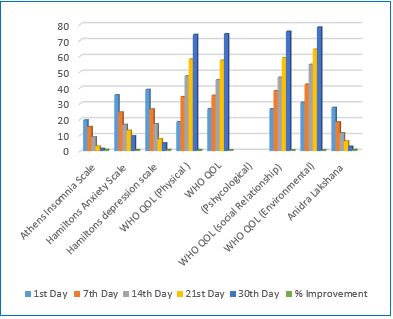Effect of Ashwagandha Kwatha Dhara in Anidra - A Case Series
DOI:
https://doi.org/10.21760/jaims.8.6.46Keywords:
Anidra, Shirodhara, Ashwagandha Kwatha Dhara, Insomnia, AyurvedaAbstract
Insomnia also known as sleeplessness, is a sleep disorder in which people have trouble in sleeping. There are around 10% to 30% of the adults have insomnia at any given point in time and up to half of people have insomnia in a given year and about 6% of people have insomnia that is not due to another problem and lasts for more than a month. The typical first line of treatment are Sleep hygiene and lifestyle changes but is restricted only to the mild cases, Moderate or severe cases requires medications like sleeping pills, sedatives, antidepressants, antipsychotic drugs like Antihistamines, Benzodiazepines etc. The side effect, dependency and withdrawal symptoms of these drugs are not new to the medical sciences. On the antagonistic part Ayurveda can provide a safe and effective non interventional solution to it by Shirodhara a Panchakarma therapeutic measure. In this case series Ashwagandha Kwatha Dhara was used to see the effect on various criteria like Athens Insomnia Scale Hamilton Anxiety Scale, Hamilton Depression Scale, WHO – Quality of scale (Bref) and Ayurveda Lakshana and an overall improvement of 86.5 % was found in all these criteria’s which was found worth sharing to the medical fraternity for enhancement and its further appraisal.
Downloads
References
Sharma RK, Das Vaidya Bhagwan, Editor. (1st Ed.) Charaka Samhita of Agnivesa, Vol. I Sutra Sthan: Chapter 11, Verse35. Varanasi: Chaukhamba Krishnadas Academy, 312; 2016.
Sharma RK, Das Vaidya Bhagwan, Editor. (1st Ed.) Charaka Samhita of Agnivesa, Vol. I Sutra Sthan: Chapter 21, Verse36. Varanasi: Chaukhamba Krishnadas Academy, 312; 2016.
Kundu C., Shukla V.D., Santwani M.A., Bhatt N.N. The role of psychic factors in pathogenesis of essential hypertension and its management by Shirodhara and Sarpagandha Vati. Ayu. 2010;31(4):436–441.
Ibid, Chikitsasthana; Vatavyadhichikisaadhyaya: chapter 28, verse 16. p. 937
Tripathi B., editor. Agnivesha. Charaka samhita of agnivesha. Chikitsasthana; Unmadachikisaadhyaya: chapter 09, verse 09. Chaukhambha Surbharati Prakashan; Varanasi: 2012.
Shreekumar T., editor. Vagbhata. Astanga Hridaya by Vagbhata. 1 ed. Harishree Hospital, Mannuthy; Kerala, India: 2008. p. 29.
Vinjamury S.P., Vinjamury M., der Martirosian C., Miller J. Ayurvedic therapy (shirodhara) for insomnia: a case series. Glob Adv Health Med. 2014;3(1):75–80
Shukla J.P., editor. Prayag: Sudha Nidhi Granthavali. 1981. Anonymous. Dharakalpa; pp. 9–10.
Vasudevan Nampoothiri LM, S.Gopakumar. Panchakarma-problems and solutions & principles and practice of Dhara. Derisanamcope,Tamilnadu, India: Sarada Mahadeva Iyer Ayurvedic Educational and Charitable Trust. 218-219 pp.
Uebaba K., Xu F.H., Tagawa M., Asakura R., Itou T., Tatsuse T. Using a healing robot for the scientific study of shirodhara. Altered states of consciousness and decreased anxiety through Indian dripping oil treatments. IEEE Eng Med Biol Mag. 2005;24(2):69–78.
Uebaba K., Xu F.H., Ogawa H., Tatsuse T., Wang B.H., Hisajima T. Psychoneuroimmunologic effects of Ayurvedic oil-dripping treatment. J Alternative Compl Med. 2008;14(10):1189–1198.
Santwani K., Shukla V..D., Santwani M.A., Thaker G. An assessment of Manasika Bhavas in menopausal syndrome and its management. Ayu. 2010;31(3):311–318. doi: 10.4103/0974-8520.77156.
Bhattacharya et al., (1987)
Nicolaides NC, Vgontzas AN, Kritikou I, Chrousos G. HPA Axis and Sleep. 2020 Nov 24. In: Feingold KR, Anawalt B, Boyce A, Chrousos G, de Herder WW, Dhatariya K, Dungan K, Grossman A, Hershman JM, Hofland J, Kalra S, Kaltsas G, Koch C, Kopp P, Korbonits M, Kovacs CS, Kuohung W, Laferrère B, McGee EA, McLachlan R, Morley JE, New M, Purnell J, Sahay R, Singer F, Stratakis CA, Trence DL, Wilson DP, editors. Endotext [Internet]. South Dartmouth (MA): MDText.com, Inc.; 2000–. PMID: 25905298.
Vgontzas AN, Bixler EO, Lin HM, Prolo P, Mastorakos G, Vela-Bueno A, Kales A, Chrousos GP. Chronic insomnia is associated with nyctohemeral activation of the hypothalamic-pituitary-adrenal axis: clinical implications. J Clin Endocrinol Metab. 2001 Aug;86(8):3787-94. doi: 10.1210/jcem.86.8.7778. PMID: 11502812.
Grandhi A, Mujumdar AM, Patwardhan B. A comparative pharmacological investigation of Ashwagandha and Ginseng. J Ethnopharmacol. 1994 Dec;44(3):131-5. doi: 10.1016/0378-8741(94)01119-2. PMID: 7898119.
Langade D, Kanchi S, Salve J, Debnath K, Ambegaokar D. Efficacy and Safety of Ashwagandha (Withania somnifera) Root Extract in Insomnia and Anxiety: A Double-blind, Randomized, Placebo-controlled Study. Cureus. 2019 Sep 28;11(9):e5797. doi: 10.7759/cureus.5797. PMID: 31728244; PMCID: PMC6827862.
Ziauddin M, Phansalkar N, Patki P, Diwanay S, Patwardhan B. Studies on the immunomodulatory effects of Ashwagandha. J Ethnopharmacol. 1996 Feb;50(2):69-76. doi: 10.1016/0378-8741(95)01318-0. PMID: 8866726.
John Beard, Iron Deficiency Alters Brain Development and Functioning, The Journal of Nutrition, Volume 133, Issue 5, May 2003, Pages 1468S–1472S, https://doi.org/10.1093/jn/133.5.1468S
Peirano PD, Algarín CR, Garrido MI, Lozoff B. Iron deficiency anemia in infancy is associated with altered temporal organization of sleep states in childhood. Pediatr Res. 2007 Dec;62(6):715-9. doi: 10.1203/PDR.0b013e3181586aef. PMID: 17957147; PMCID: PMC2367007.
Onder G, Penninx BW, Cesari M, Bandinelli S, Lauretani F, Bartali B, Gori AM, Pahor M, Ferrucci L. Anemia is associated with depression in older adults: results from the InCHIANTI study. J Gerontol A Biol Sci Med Sci. 2005 Sep;60(9):1168-72. doi: 10.1093/gerona/60.9.1168. PMID: 16183958.
Speers AB, Cabey KA, Soumyanath A, Wright KM. Effects of Withania somnifera (Ashwagandha) on Stress and the Stress-Related Neuropsychiatric Disorders Anxiety, Depression, and Insomnia. Current Neuropharmacology. 2021 Jul. DOI: 10.2174/1570159x19666210712151556.
Kaushik MK, Kaul SC, Wadhwa R, Yanagisawa M, Urade Y. Triethylene glycol, an active component of Ashwagandha (Withania somnifera) leaves, is responsible for sleep induction. Plos one. 2017 ;12(2):e0172508. DOI: 10.1371/journal.pone.0172508.















